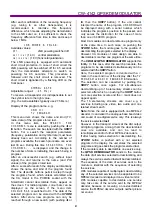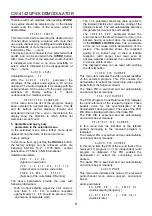
CW-4142 QPSK DEMODULATOR
After each modification of the receiving frequency
(e.g. tuning to an other transponder) it is
recommended to minimize this frequency
difference, which means adjusting the demodulator
to the LNB. Later on, it is sufficient to check the
frequency difference from time to time and keep it
below 1 MHz.
LNB POWER & POLAR.
Available values:
Off
LNB powering switched off
Vertical
(14 V)
vertical polarization
Horizontal
(18 V) horizontal polarization
The LNB powering is equipped with automatic
short circuit protection. In case of short circuit the
LNB powering will be switched off for 4.5 seconds
then the demodulator attempts to switch on
powering for 0.5 seconds. This procedure is
followed until the short circuit is removed. The
short circuit is signalized by a flashing LED on the
front panel.
SYMBOL RATE
Adjustable range:
2
...
45 Ms/s
To receive a transponder it is indispensable to set
the symbol rate to the right value.
(E.g. the Astra satellites typically use 27.5 Ms/s.)
Display of the program name, e.g.
CNN Int.
TV PROGRAM
This menu item shows the name and kind (TV,
radio, data) of the program stored last.
In this menu item, the
SEARCH FOR
CHANNELS
menu is entered by pushing the
W
or
X
button. The search can be started with the
SHIFT
button. For a search the reception parameters
(frequency, polarization and symbol rate) must have
already been set. According to the number of
programs available, the search procedure can even
last 30 sec. During this time
SEARCHING FOR
CHANNELS...
is displayed, and the change in
the number of dots is indicating the search being in
progress.
After an unsuccessful search (e.g. without input
signal) the unit returns to the name (and PID
values) of the program stored last.
After a successful search the display automatically
shows the name and kind of the program found
first. The
W
and
X
buttons permit to step through
the programs found, which unless scrambled and
the CA modul in the PCMCIA socket with the
SmartCard cannot descramble them, appear on
the screen. For radio programs, colour bars can be
displayed on the screen, if the menu item
COLOUR BAR
is switched to
On
. The data of the
selected program can be stored with the
STORE
button. After store, new programs can only be
reached through a new search (with pushing
W
or
X
, then the
SHIFT
button). If the unit cannot
interpret the name of the program,
UNKNOWN
will
be displayed along with a serial number, which
indicates the program’s position in the packet, and
only serves the distinction for the case of more
than one
UNKNOWN
program.
Most CA modules can descramble one program only
at the same time. In such case, on pushing the
STORE
button, the module goes to the position of
descrambling the program selected to the display.
However CA modules of later design are able to
descramble more than one program at the same time.
The
CW-4142 QPSK DEMODULATOR
supports this
facility. In this case, after the search procedure, the
programs to be descrambled simultaneously can be
selected with the
SHIFT
button.
Here, the selected program is denoted with a
<
mark in the second row of the display after the
TV
PROGRAM
or
RADIO PROGRAM
information.
The selection can be cancelled by pushing the
SHIFT
button once again. For simultaneous
descrambling up to 16 elementary streams can be
selected, after which on pushing the
SHIFT
button
no more selection occurs and the
<
mark does not
appear again.
The 16 elementary streams can cover e.g. 4
services including one video, two audio and one
teletext stream each.
Note:
Since the unit is equipped with one MPEG-2
decoder, it can deliver the analogue base band video
and sound of one digital service only. This is always
the service selected
last
!
However, in the transport stream at the ASI output
all digital programs, among them the descrambled
ones are available, and can be lead to
remultiplexers and/or further MPEG-2 decoders.
If after having made selection for descrambling, the
STORE
button is pushed with a not selected
program in the display, the unit stores the selected
programs and goes back the program selected last.
If the module is able to descramble one service only,
the
QPSK DEMODULATOR
sends to the module
the data of all services selected to descrambling, and
always the service selected last will be descrambled.
The sequence of the data of services sent to the
module is identical with the sequence of selecting
the services.
With modules capable of multiprogram descrambling
any of the selected services can be appointed to be
MPEG2 decoded and displayed on a video monitor.
With modules capable to descramble one service
only, take care of the service sent to the MPEG2
decoder, because on receiving a non-descrambled
service the MPEG2 decoder outputs neither picture
nor sound.
4

























